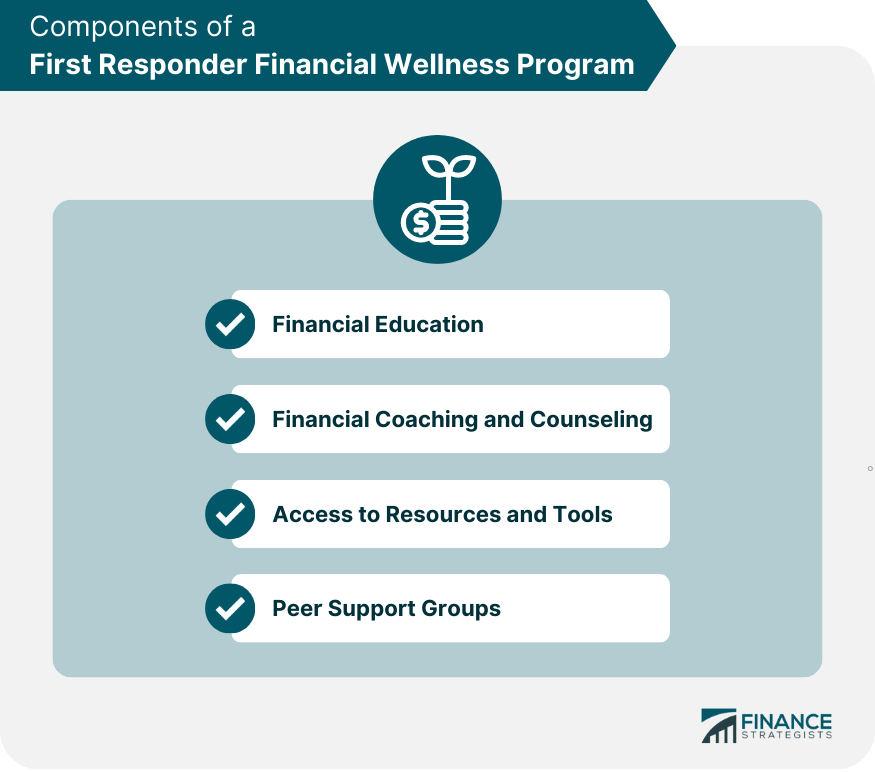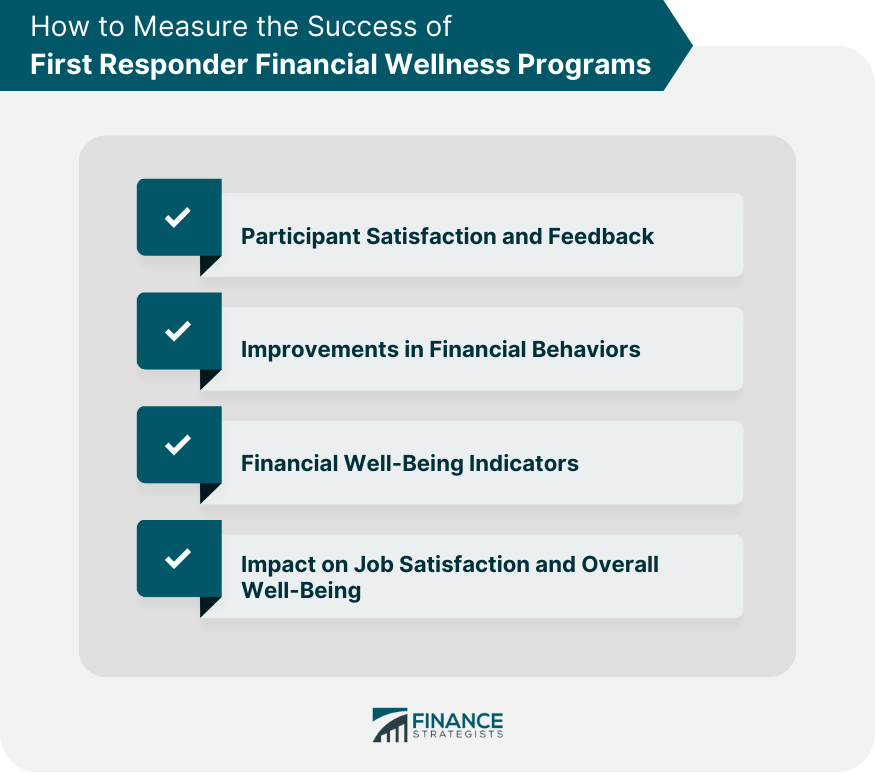First responder financial wellness programs are specialized initiatives designed to support the financial well-being of first responders, such as police officers, firefighters, and emergency medical personnel. These programs aim to address the unique financial challenges faced by first responders by providing financial education, coaching, resources, and peer support. Components of these programs typically include education on topics like budgeting, debt management, and retirement planning; individualized financial coaching and counseling; access to resources and tools, such as online platforms, workshops, and calculators; and peer support groups for sharing experiences, advice, and encouragement. Financial wellness programs should teach first responders how to create and maintain a budget, track expenses, and identify areas for improvement. Debt management education should focus on strategies for reducing debt, understanding different types of debt, and how to prioritize repayment. First responders should learn about various saving and investment options, as well as strategies for building an emergency fund and planning for long-term financial goals. Programs should provide guidance on retirement planning, including understanding pension benefits, maximizing contributions to retirement accounts, and estimating retirement income needs. First responders should receive education on insurance and risk management, including life, disability, and property insurance, as well as strategies for managing risk through proper insurance coverage. First responders should have access to one-on-one financial coaching and counseling to address their unique financial needs and goals. Financial coaches should help first responders set realistic financial goals and monitor their progress toward achieving them. Coaches should work with first responders to identify and overcome financial barriers like debt, lack of savings, or poor spending habits. Financial coaching should also address money management's emotional and behavioral aspects, helping first responders develop healthy financial habits. First responders should have access to online resources, such as budgeting apps, investment tools, and financial calculators, to help them manage their finances effectively. Financial wellness programs should offer workshops and seminars on various financial topics tailored to the unique needs of first responders. Programs should provide first responders with printed materials and resources, such as budgeting templates, debt repayment plans, and investment guides. First responders should have access to financial calculators and planners to help them make informed financial decisions and plan for the future. Peer support groups can provide first responders with a platform to share their experiences, challenges, and advice on financial matters, helping them learn from one another. Support from peers can help first responders stay motivated and committed to their financial goals, fostering a sense of camaraderie and shared purpose. Peer support groups can also facilitate networking opportunities, allowing first responders to connect with others who share similar financial challenges and goals. These groups should prioritize confidentiality and trust, creating a safe space for first responders to discuss their financial concerns openly. Employers can offer on-site financial workshops and training sessions to make it easier for first responders to access financial education and resources. Employers can also provide webinars and online resources, allowing first responders to access financial information and education at their convenience. Incentives, such as financial bonuses or additional time off, can be offered to encourage first responders to participate in financial wellness programs. Employers can partner with financial institutions and non-profit organizations to develop and deliver financial wellness programs tailored to the unique needs of first responders. Partnerships with financial institutions can provide first responders with access to specialized financial products and services designed to meet their unique needs. Community-based financial wellness initiatives can offer workshops and seminars for first responders, leveraging local resources and expertise. Community initiatives can also involve collaboration with local financial advisors who have experience working with first responders. Existing community resources, such as libraries and community centers, can be utilized to provide financial education and support to first responders. Regularly gathering participant feedback can help identify improvement areas and gauge overall satisfaction with the program. Tracking changes in financial behaviors, such as increased savings, reduced debt, and better spending habits, can help measure the effectiveness of financial wellness programs. Monitoring key financial well-being indicators, such as debt reduction, increased savings and investments, and greater financial stability, can provide insights into the program's overall impact. Evaluating the effects of financial wellness programs on job satisfaction and overall well-being can help demonstrate the broader benefits of these initiatives. First responder financial wellness programs are essential initiatives designed to provide support and resources to first responders, such as police officers, firefighters, and emergency medical personnel. These programs aim to address the unique financial challenges faced by first responders by providing financial education, coaching, resources, and peer support. Components of these programs typically include financial education, financial coaching and counseling, access to resources and tools, and peer support groups. Implementation strategies for these programs include employer-sponsored programs, partnerships with financial institutions and non-profit organizations, and community-based initiatives. Measuring the success of these programs can be done by tracking changes in financial behaviors, monitoring key financial well-being indicators, and evaluating the effects of financial wellness programs on job satisfaction and overall well-being. What Are First Responder Financial Wellness Programs?
Components of a First Responder Financial Wellness Program
Financial Education
Budgeting and Expense Management
Debt Management
Saving and Investing
Retirement Planning
Insurance and Risk Management
Financial Coaching and Counseling
Individualized Guidance
Goal Setting and Monitoring Progress
Overcoming Financial Barriers
Behavioral and Emotional Support
Access to Resources and Tools
Online Platforms and Apps
Workshops and Seminars
Printed Materials and Resources
Financial Calculators and Planners
Peer Support Groups
Sharing Experiences and Advice
Encouragement and Motivation
Networking Opportunities
Confidentiality and Trust

Implementation Strategies for First Responder Financial Wellness Programs
Employer-Sponsored Programs
On-Site Workshops and Training
Webinars and Online Resources
Incentives for Participation
Partnerships With Financial Institutions and Non-Profit Organizations
Collaborative Program Development
Access to Specialized Financial Products and Services
Community-Based Initiatives
Local Workshops and Seminars
Collaboration With Local Financial Advisors
Utilizing Existing Community Resources
Measuring the Success of First Responder Financial Wellness Programs
Participant Satisfaction and Feedback
Improvements in Financial Behaviors
Financial Well-Being Indicators
Impact on Job Satisfaction and Overall Well-Being

Conclusion
These programs are crucial in helping first responders achieve financial stability and well-being, ultimately contributing to their overall job satisfaction and well-being.
First Responder Financial Wellness Programs FAQs
First Responder Financial Wellness Programs are educational and support initiatives designed to help first responders, such as police officers, firefighters, and emergency medical personnel, address their unique financial challenges and achieve financial well-being.
First Responder Financial Wellness Programs are important because they address the unique financial challenges faced by first responders, such as unpredictable schedules, high stress, and early retirement. These programs help first responders make informed financial decisions, reduce financial stress, and improve their overall well-being.
First Responder Financial Wellness Programs typically include financial education on topics like budgeting, debt management, and retirement planning; financial coaching and counseling for individualized guidance and support; access to resources and tools, such as online platforms and workshops; and peer support groups to share experiences and advice.
Employers can implement First Responder Financial Wellness Programs by offering on-site workshops and training, providing webinars and online resources, and creating incentives for participation. Employers can also collaborate with financial institutions, non-profit organizations, and community initiatives to develop and deliver tailored programs for their first responders.
The success of First Responder Financial Wellness Programs can be measured by evaluating participant satisfaction and feedback, tracking improvements in financial behaviors, monitoring key financial well-being indicators such as debt reduction and increased savings, and assessing the impact on job satisfaction and overall well-being.
True Tamplin is a published author, public speaker, CEO of UpDigital, and founder of Finance Strategists.
True is a Certified Educator in Personal Finance (CEPF®), author of The Handy Financial Ratios Guide, a member of the Society for Advancing Business Editing and Writing, contributes to his financial education site, Finance Strategists, and has spoken to various financial communities such as the CFA Institute, as well as university students like his Alma mater, Biola University, where he received a bachelor of science in business and data analytics.
To learn more about True, visit his personal website or view his author profiles on Amazon, Nasdaq and Forbes.











